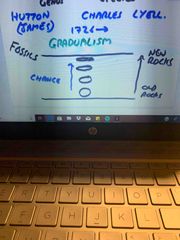![]()
![]()
![]()
Use LEFT and RIGHT arrow keys to navigate between flashcards;
Use UP and DOWN arrow keys to flip the card;
H to show hint;
A reads text to speech;
20 Cards in this Set
- Front
- Back
|
History of Natural Selection |

Creation • Aristotle 384-322 BC. “Scale of nature” ladder • Carolus Linnaeus (1707-1778) - Taxonomy (classification) e.g. HomoSapiens (Homo= Genus, Sapiens= Species) • James Hutton & Charles Lyell - Gradualism (Pictured above) • Jean Baptist’s Lamarck 1- Organisms adapted to the environment 2- Changes in individuals were passed on - not true • Charles Darwin - Scientific officer - Adaptation to ecological niches. 1859 “Origin of Species” |
|
|
Natural Selection |
1) Principle of Variation - Inherent variability in a population 2) Principles of Heredity - Variation can be passed down generations 3) Principles of selections - Organisms over-multiply - Some individuals have a higher capacity to survive |
|
|
Evidence for natural selection |
1) Biogeography e.g. Darwin’s Finches 2) Fossil Record 3) Comparative Anatomy e.g. Mammalian forelimb 4) Comparative Embryology 5) DNA - Similarity, e.g. chimps & humans = 98%. Dogs & humans = 85% |
|
|
Principle of Variation |
• Genetic Polymorphism - Changes in DNA sequence • Phenotypic Polymorphism - What it looks like Genotype - DNA determines the Phenotype Variability is dependent on differences in the DNA sequence |
|
|
Mechanisms that generate variation |
1) Gene Mutation, e.g. Drosophila Eye Colour- single gene 2) Chromosomes mutation - Changes in the number of chromosomes - Addition or loss 3) Recombination - New arrangement - Sexual reproduction |
|
|
Principle of Heredity |
A species- All members of a species can interbreed - Not all have the opportunity A population- A group of organisms within the same species that have the opportunity to interbreed |
|
|
Principle of selection |
• Tend to over-multiply • Best adapted out-compete others |
|
|
Selective Pressures |
1) Evasion of Predators, e.g. Boston Betularia 2) Competition for food, e.g. Giraffe 3) Resistance to disease, e.g. Cattle in Africa- Sleeping Sickness (Nagana) 4) Selection for metabolic fitness, e.g. Micro-organisms 5) Sexual selection, e.g. Mate choice 6) Resistance against toxins 7) Artificial Selection |
|
|
Change in Gene Frequencies |
Back (Definition) |
|
|
Modes of Selection (1) |
Back (Definition) |
|
|
Modes of Selection (2) |
Back (Definition) |
|
|
Modes of Selection (3) |
Back (Definition) |
|
|
Modes of Selection (4) |
Back (Definition) |
|
|
Balanced Selection |
E.g. Sickle Cell Anaemia - Very frequent in Africa Partial protection against Malaria |
|
|
Sexual Reproduction |
Asexual Reproduction - Rapid reproduction - Limited variability (Clonal) - Limited adaptability Sexual Organisms Male X Female - Inheritance from both parents - Variability (higher) - Lower reproductive rate - Higher adaptability A lot have both speciation • Formation of new species - < 100 new species per year |
|
|
Diversifying Selection Occurring (1) |
Back (Definition) |
|
|
Diversifying Selection Occurring (2) |
Back (Definition) |
|
|
Anagenesis |
Back (Definition) |
|
|
Types of isolation (1) |
1) Geographical Isolation |
|
|
Types of isolation (2) |
2) Habitat Isolation • e.g. Darwin’s Finches - Utilised different compartments of the habitat 3) Behavioural Isolation • e.g. Fireflies - Males attract by flashing - Different patterns for different species 4) Temporal Isolation • Plants E.g. Skunks - W. Spotted Skunk- breeds late summer - E. Spotted Skunk- breeds winter 5) Mechanical Isolation E.g. spiders - shape recognised by female 6) Gametic Isolation - Sperm & Egg incompatible 7) Hybrid Sterility - Crossed species -> between infertile hybrids - e.g. Horse X Donkey = Mule (infertile)! |

